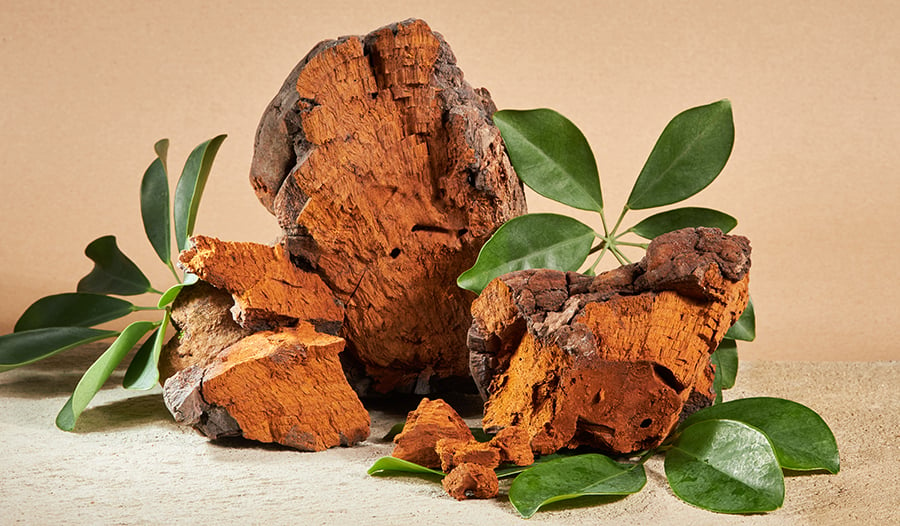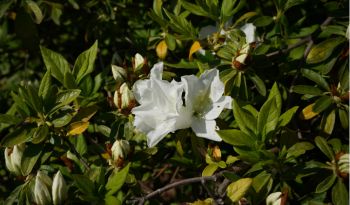Гъби Чага: Използване, ползи и странични ефекти

Какво е Чага?
Чага (Inonotus obliquus) е лечебна гъба , произхождаща от Русия, Сибир, Европа, Канада и северните части на САЩ и Източна Азия. Тази гъба се развива предимно по брезата, но може да расте и по различни други широколистни дървесни видове, включително бук, дъб, елша и ясен. Чага се появява под формата на конус - тъмнокафяв или черен дървесен израстък, наподобяващ корава, изгоряла маса по стволовете на тези дървета.
Под тъмната си дървесна външност чага има ярко ръждива плът, пълна с антиоксидантни съединения. Въпреки че технически чага не е гъба, тя често се нарича "лечебна гъба", защото също е гъба като гъбите.
Традиционни употреби на гъбите чага
Чага има богата история на употреба в сибирската, руската, скандинавската и индианската народна медицина. В тези системи на традиционната медицина се е смятало, че чага притежава широк спектър от лечебни свойства. Сред коренното население на Сибир традиционно се използва за насърчаване на дълголетието, облекчаване на храносмилателни разстройства, облекчаване на настинки и респираторни инфекции и се използва локално при кожни заболявания.
Шишарките на чага обикновено се настъргват на фин прах и традиционно се приготвят като чай или отвара. Днес този прах може да се приема под формата на чай, тинктура, прах или капсула. Чага се предлага самостоятелно и като компонент на смеси от лечебни гъби . Смесите от гъби често се продават под формата на прах и се смесват с други течности за ежедневна употреба.
Популярността на чага нарасна през последните години поради репутацията ѝ на адаптоген и потенциалната ѝ роля за укрепване на цялостното здраве и подобряване на различни медицински състояния. Днес съвременните научни изследвания се основават на традиционните знания и изследват многобройните ползи от чага за здравето.
Хранителни вещества за гъби чага
Чага съдържа голямо разнообразие от биоактивни съединения, отговорни за здравословните ѝ ефекти. По-долу са изброени някои от основните съставки, които се съдържат в чага:
Полизахариди
Чага е богата на бета-глюкани. , полизахарид, известен с имуноукрепващите си свойства. Тези съединения могат да засилят активността на имунните клетки, като макрофаги и Т-клетки, като помагат на организма да се защити от инфекции и заболявания. Бета-глюкани се съдържат и в други медицински гъби като рейши и майтаке. , овес, морски водораслии водорасли.
Антиоксиданти
Чага е отличен източник на антиоксиданти. , включително фенолни съединения и флавоноиди. Тези антиоксиданти помагат в борбата с оксидативния стрес и намаляват клетъчните увреждания, причинени от свободните радикали, и могат да увеличат супероксиддисмутазата и глутатиона в организма.
Бетулинова киселина
Когато расте върху брези, чага може да натрупва бетулинова киселина от дървото. Бетулиновата киселина е показала обещаващи противовъзпалителни и антитуморни свойства в предклинични проучвания.
Меланин
Тъмният цвят на чага се дължи на високото съдържание на меланин. Меланинът може да действа като антиоксидант и да предлага защитни ефекти срещу оксидативен стрес. В човешкия организъм меланинът отговаря за пигментацията на кожата и помага за блокиране на ултравиолетовата радиация, която може да увреди ДНК в клетките на кожата, което води до рак на кожата и стареене. Хранителни вещества като тирозин и мед са важни за производството на меланин.
Ползи за здравето на гъбите чага
1. Модулация на имунната система
Свойствата на Чага за повишаване на имунната защита се дължат на нейните полизахариди, включително бета-глюкани. Тези съединения стимулират производството и активността на имунните клетки, като повишават способността на организма да се противопоставя на инфекциите.
Доказано е, че бета-глюканите активират клетките на нашата вродена имунна система. Тези типове клетки са първият отговор на патогените и започват да се борят с инфекциите, преди имунната ни система да е започнала да произвежда специфични антитела срещу нахлуващите микроби. Освен това чага може да подобри производството на цитокини или химически пратеници, които помагат на имунните клетки да общуват помежду си.
2. Намаляване на възпалението
Възпалението е замесено в развитието на много хронични заболявания. Бетулиновата киселина, която се съдържа в изобилие в чага, е показала противовъзпалителни ефекти в предклинични проучвания. Тези резултати показват, че чага може да има потенциално приложение при лечение на възпалителни състояния поради високото съдържание на бетулинова киселина. Освен това чага съдържа и други антиоксидантни и противовъзпалителни съединения, които могат да помогнат за намаляване на окислителното увреждане от възпаленията в организма.
3. Адаптогенни свойства
Чага се използва в традиционната медицина за насърчаване на жизнеността и цялостното здраве. Тази гъба е мощен адаптоген. , вещество, за което се смята, че помага на организма да се адаптира към стресовите фактори и да поддържа хомеостазата.
Макар че чага може да не е толкова известна, колкото популярните адаптогени като ашваганда или родиола. , историческата и традиционната употреба потвърждават, че чага отдавна се използва, за да помогне на телата ни да отговорят на изискванията на околната среда. Последните проучвания върху животни показват, че чага може да подобри физиологичната реакция при стресови ситуации.
4. Антибактериални и антивирусни ефекти
Освен за ефектите върху имунната система, чага е изследвана и за антивирусните и антибактериалните си свойства. Някои проучвания показват, че екстрактите от чага могат да потискат растежа на някои вируси и бактерии.
Едно скорошно проучване, базирано на компютърен модел, показва, че съставките на чага, включително бета-глюкани, бетулинова киселина и други полизахариди, могат да блокират свързването на SARS-CoV-2 с човешки клетки. Въпреки че са необходими допълнителни изследвания, тези резултати показват, че чага може да има мощни антимикробни свойства срещу различни патогени.
Чага може да бъде мощен съюзник в подкрепа на реакцията на организма към нахлуващите патогени, благодарение на антимикробното и имуностимулиращото си действие.
5. Може да поддържа здравословна кръвна захар и метаболизъм
Полизахаридните съединения на чага са показали, че подобряват регулирането на кръвната захар и холестерола при проучвания върху животни. В едно проучване при мишки, хранени с полизахариди от чага, се наблюдава подобряване на кръвната захар на гладно и намаляване на инсулиновата резистентност. Други проучвания върху животински модели показват, че полизахаридите на чага могат да намалят общия холестерол, LDL "лошия" холестерол и триглицеридите, като същевременно повишат защитния за сърцето HDL холестерол.
Тъй като тези проучвания са проведени само върху животни, не може да се каже дали тези ефекти се отнасят и за хората, но резултатите са обещаващи и дават основание за допълнителни изследвания на въздействието на чага върху метаболизма, кръвната захар и холестерола.
6. Синергични ефекти
Чага често се смесва с други лечебни и адаптогенни гъби. , като рейши. , шийтаке. , кордицепс. и лъвска грива. Всеки вид лечебна гъба или гъба има различни свойства и съставки. Чрез смесването им можем да изпитаме ефекти от няколко вида, които могат да се допълват взаимно.
Например чага може да действа енергизиращо на някои хора, докато рейши има по-успокояващ характер. Едновременното използване на тези две гъбички може да подобри ефекта и на двете. Освен това много медицински гъби съдържат мощни имуномодулиращи съединения, така че използването на няколко вида гъби може да помогне за допълване на протокола за имунна подкрепа.
Чага гъби странични ефекти
Чага обикновено се счита за безопасна за повечето хора, когато се консумира в умерени количества. Въпреки това има някои важни съображения и потенциални рискове за някои хора.
Поради потенциалния си ефект на разреждане на кръвта чага може да взаимодейства с някои лекарства, особено с антикоагуланти и антитромбоцитни лекарства. Лицата, които приемат лекарства за разреждане на кръвта, трябва да се консултират с медицинско лице, преди да използват чага. Тъй като чага може да понижи кръвната захар, хората, които приемат лекарства или добавки за диабет, трябва да се консултират с медицинско лице, преди да използват чага.
Чага съдържа оксалова киселина, която в големи количества може да причини проблеми с бъбреците или да спомогне за развитието на камъни в бъбреците. Лица с анамнеза за камъни в бъбреците или бъбречно заболяване трябва да бъдат предпазливи при употребата на чага.
Макар и рядко, някои хора могат да бъдат алергични към чага, което води до алергични реакции при консумация. Добре е да започнете с малка доза, за да прецените поносимостта, особено ако консумирате чага за първи път.
Чага може да натрупва тежки метали от околната среда. Качеството и чистотата на чага могат да варират значително при различните марки и източници. Важно е да се снабдявате с добавки или екстракти от чага от реномирани доставчици, за да се гарантира безопасността и ефикасността.
Устойчиви ли са гъбите чага?
Свръхдобивът на чага се превърна в проблем поради нарастващата ѝ популярност. Чага е сравнително лесна за разпознаване, затова е склонна към прекомерна реколта. Това представлява значителна заплаха както за популациите на чага, така и за екосистемите, които те обитават.
Устойчивите практики за събиране на реколтата са от решаващо значение за осигуряване на дългосрочна наличност на чага и за опазване на деликатния баланс на горските екосистеми. Като наблягаме на отговорните методи на събиране, ограничаваме добива до устойчиво ниво и зачитаме естествения цикъл на растеж на чага, можем да запазим това ценно лекарство за бъдещите поколения.
Вземане на храна
Чага се използва от векове в традиционната медицина. Тази лечебна гъба и нейните съставки имат широк спектър от въздействия върху организма, включително поддържане на имунната система, намаляване на възпаленията и увеличаване на антиоксидантите. В предклинични проучвания чага е показала много ползи за здравето, включително антибактериални и антивирусни свойства. Въпреки че научните доказателства в подкрепа на тези твърдения са окуражаващи, за окончателното установяване на ефекта от употребата на този продукт са необходими допълнителни изследвания, включително клинични изпитвания върху хора.
Препратки:
- Lee M.W., Hur H., Chang K.C., Lee T.S., Ka K.H., Jankovsky L. Въведение в разпространението и екологията на стерилните конуси на Inonotus obliquus. Микобиология. 2008;36:199-202.
- Lu Y, Jia Y, Xue Z, Li N, Liu J, Chen H. Последни постижения в областта на полизахаридите на гъбата Inonotus obliquus (Chaga): Изолиране, структурни характеристики, биологични дейности и приложение. Полимери (Базел). 2021 Apr 29;13(9):1441.
- Niu H., Song D., Mu H.B., Zhang W.X., Sun F.F., Duan J.Y. Изследване на три лигнинови комплекса с антиоксидантен и имунологичен капацитет от Inonotus obliquus. Инт. J. Biol. Macromol. 2016;86:587-593.
- Géry A, Dubreule C, André V, Rioult JP, Bouchart V, Heutte N, Eldin de Pécoulas P, Krivomaz T, Garon D. Чага (Inonotus obliquus), бъдеща потенциална лекарствена гъба в онкологията? Химично изследване и сравнение на цитотоксичността спрямо клетки на човешки белодробен аденокарцином (A549) и човешки бронхиални епителни клетки (BEAS-2B). Integr Cancer Ther. 2018 Sep;17(3):832-843.
- Фулда С. Бетулинова киселина за лечение и профилактика на рак. Int J Mol Sci. 2008 Jun;9(6):1096-1107.
- Xu L., Yu Y.F., Sang R., Ge B.J., Wang M., Zhou H.Y., Zhang X.M. Полизахаридът Inonotus obliquus предпазва от нежелана бременност, причинена от инфекция с Toxoplasma gondii, чрез регулиране на баланса Th17/Treg по пътя на TLR4/NF-kappa B. Инт. J. Biol. Macromol. 2020;146:832-840.
- Kang J. H., Jang J. E., Mishra S. K., Lee H. J., Nho C. W., Shin D., et al. (2015). Ергостероловият пероксид от гъбата чага (Inonotus Obliquus) проявява противоракова активност чрез понижаване на регулацията на пътя на β-катенин при колоректален рак. J. Ethnopharmacol. 173, 303-312.
- Arata S, Watanabe J, Maeda M, Yamamoto M, Matsuhashi H, Mochizuki M, Kagami N, Honda K, Inagaki M. Непрекъснатият прием на воден екстракт от гъбата Чага (Inonotus obliquus) потиска прогресията на рака и поддържа телесната температура при мишки. Heliyon. 2016 May 12;2(5):e00111.
- Lemieszek MK, Langner E, Kaczor J, Kandefer-Szerszeń M, Sanecka B, Mazurkiewicz W, Rzeski W. Противоракови ефекти на фракция, изолирана от плодните тела на медицинската гъба Чага, Inonotus obliquus (Pers.:Fr.) Pilát (Aphyllophoromycetideae): in vitro изследвания. Int J Med Mushrooms. 2011;13(2):131-43.
- Glamočlija J, Ćirić A, Nikolić M, Fernandes Â, Barros L, Calhelha RC, Ferreira IC, Soković M, van Griensven LJ. Химично охарактеризиране и биологична активност на Чага (Inonotus obliquus), медицинска "гъба". J Ethnopharmacol. 2015 Mar 13;162:323-32.
- Eid JI, Al-Tuwaijri MM, Mohanty S, Das B. Полизахаридите на гъбата чага (Inonotus obliquus) проявяват генопротективен ефект при изложени на UVB лъчи ембрионални зебри (Danio rerio) чрез координирана експресия на гени за възстановяване на ДНК. Heliyon. 2021 Feb 4;7(2):e06003.
- Wang J, Wang C, Li S, Li W, Yuan G, Pan Y, Chen H. Антидиабетни ефекти на полизахаридите на Inonotus obliquus при мишки с диабет тип 2, предизвикани от стрептозотоцин, и потенциален механизъм чрез сигналния път PI3K-Akt. Biomed Pharmacother. 2017 Nov;95:1669-1677.
- Yang M, Hu D, Cui Z, Li H, Man C, Jiang Y. Липидопонижаващи ефекти на полизахарида Inonotus obliquus in vivo и in vitro. Храни. 2021; 10(12):3085.
- Hyun KW, Jeong SC, Lee DH, Park JS, Lee JS. Изолиране и характеризиране на нов пептид, инхибиращ агрегацията на тромбоцитите, от медицинската гъба Inonotus obliquus. Пептиди. Jun 2006;27(6):1173-1178.
- Kwon O, Kim Y, Paek JH, Park WY, Han S, Sin H, Jin K. Оксалатна нефропатия, предизвикана от гъбата чага, която клинично се проявява като нефротичен синдром: Доклад за случай. Медицина (Балтимор). 2022 Mar 11;101(10):e28997.
ОТКАЗ ОТ ОТГОВОРНОСТ:Този УЕЛНЕС ХЪБ няма за цел да поставя диагнози...

















































































 Съдържание
Съдържание















